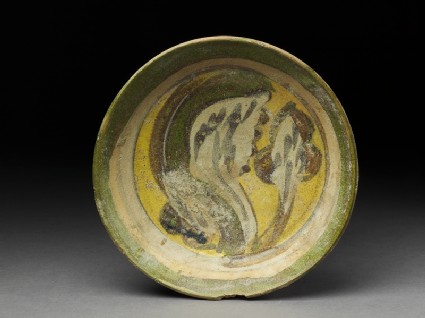Browse: 105 objects
- Reference URL
Actions
Dish with polychrome glazing
-
Description
Although glazing had been in use for 100s of years in the Near East, early Muslim potters found themselves increasingly experimenting with polychrome glazes. This plate, decorated with lead-based glazes in green, yellow, and brown, has been intepreted as an early, although only partially successful, attempt to combine different colours side by side on the same surface.
-
Details
- Associated place
- Date
- 8th - 9th century AD (AD 701 - 900)
- Associated people
-
American Research Center in Egypt (established 1948) (excavator)
- Material and technique
- earthenware, with decoration in coloured glazes
- Dimensions
-
3.9 cm (height)
18.5 cm (diameter)
- Material index
- Technique index
- Object type index
- No. of items
- 1
- Credit line
- Presented by the American Research Center in Egypt, 1974.
- Accession no.
- EA1974.48
-
Further reading
Allan, James W., Islamic Ceramics, Ashmolean-Christie's Handbooks (Oxford: Ashmolean Museum, 1991), no. 4 on p. 10, illus. p. 11
Glossary
earthenware
-
earthenware
Ceramic material made of clay which is fired to a temperature of c.1000-1200⁰c. The resulting ceramic is non-vitreous and varies in colour from dark red to yellow.
Location
Objects are sometimes moved to a different location. Our object location data is usually updated on a monthly basis. Contact the Jameel Study Centre if you are planning to visit the museum to see a particular object on display, or would like to arrange an appointment to see an object in our reserve collections.
Publications online
-

Islamic Ceramics
Two different traditions of glazing were inherited by the Muslims through their conquest of the Near East in the seventh century. In the east the Sasanian Persians had used a glaze fluxed with soda or potash, called an alkaline glaze. In the west the Romans had developed a glaze fluxed with lead-oxide, called a lead glaze.
The earliest Islamic wares of Egypt continue the latter tradition, but show that a new period of experimentation was under way. For among the 8th century glazed objects given to the Ashmolean from the American Research Centre in Egypt’s excavations at Fustat (Old Cairo) is a bowl with a very uneven, speckly, monochrome green lead glaze. This suggests itself an early experiment with glazing. Secondly there is a fragment with broad stripes in green, ochre and dark brown, suggesting a phase of putting different coloured glazes side-by-side on the same object. Thirdly there is the bowl illustrated here in which the different glazes – green, brown and yellow – have been used to portray a highly stylised peacock. Although the design itself is remarkably sophisticated, it is evident that the experimental phase is not yet complete, for, alongside the decorated areas, the potter has left parts of the bowl surface completely unglazed.
Collection trails
Galleries
© 2013 University of Oxford - Ashmolean Museum








